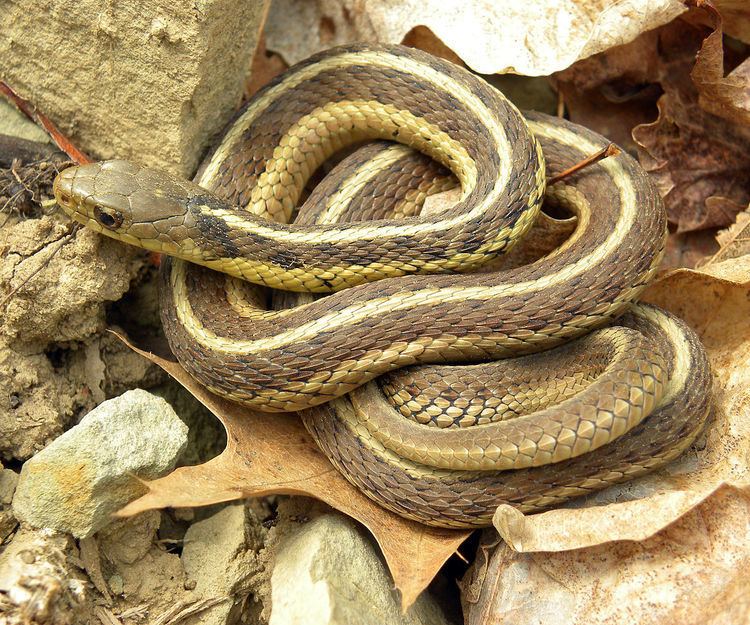Subphylum Vertebrata | Phylum Chordata Class Reptilia Suborder Serpentes | |
 | ||
The eastern garter snake (Thamnophis sirtalis sirtalis) is a medium-sized snake that is indigenous to North America.
Contents
Taxonomy and etymology
The scientific name Thamnophis sirtalis sirtalis is a combination of Ancient Greek and New Latin that means "bush snake that looks like a garter strap". The generic name "Thamnophis " is derived from the Greek "thamnos" (bush) and "ophis" (snake) and the New Latin "siratalis" (like a garter). The specific name sirtalis is a reference to the snake's pattern resembling a striped garter strap.
Description
Eastern garter snakes average between 46–66 cm (18–26 in) long. The largest recorded length was 124 cm (48.7 in) long. Females are typically larger than males. They are either a greenish, brown, or black color and have a distinct yellow or white stripe.
Bluestripe garter snake (Thamnophis sirtalis similis )
Description: Average adult size is 20–26 inches (50.8-66 cm), record is 39.25 inches (99.6 cm). Adults are olive–brown to blue–black with a light blue mid–dorsal stripe. There is an additional light blue stripe on each side of the body occupying the second and third dorsal scale rows above the belly. Frequently there are light tannish flecks on each side between the mid–dorsal and lateral stripes. The belly is uniform whitish–blue. The scales of the upper lip are outlined with black markings. The scales are keeled, and there are 19 dorsal scale rows at midbody. The pupil is round. Juveniles are similar to adults.
Range: In Florida, the bluestripe garter snake occurs along the Gulf coast from eastern Wakulla County in the panhandle south to Hernando County in the central peninsula. It is not found outside of Florida.
Reproduction
Eastern garter snakes are ovoviviparous, giving birth to live young. Many males may try to mate with one female, resulting in a "breeding ball". The young are 13–23 cm (5–9 in) long at birth.
Distribution and habitat
The eastern garter snake has a wide range across eastern North America, going as far north as southern Ontario and Quebec to the Gulf of Mexico in the south, along the eastern shores of America to the Mississippi River. In New England, the snake is described as the "most widespread and ubiquitous" serpent, from wilderness to urban environments and from sea level to high elevations.
The eastern garter snake will live in a variety of environments, with a preference for grassy or shrubby fields, including abandoned farmland, outbuildings and trash dumps. In particular the snake likes to inhabit stone walls that separate the forest from fields. It is also found along moist habitats such as lakes, rivers, streams, swamps, bogs, ponds, drainage ditches, quarries. Snakes are present in urban environments in habitats that include "city parks, cemeteries and suburban yards and gardens". Eastern garter snakes like to conceal themselves under logs, stones and other debris that allow them to bask in the sunlight and quickly seek refuge from predators. Krulikowski notes that "[o]ld poultry farms with discarded sheet-metal incubation trays provide warm, moist hiding places."
Feeding
They mostly eat toads, frogs, slugs, and worms, but they will eat almost anything that they can overpower.
